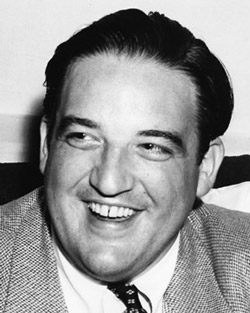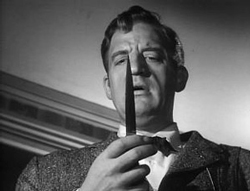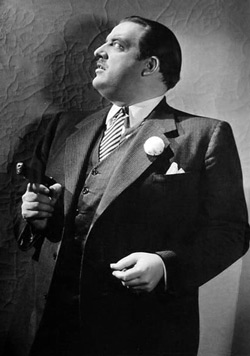 Film actors subject themselves to a level of scrutiny that most of us would find unbearable. True, they do this out of ego and ambition, but that doesn’t change the cold hard fact that they make their living being objectified. Most of us would be creeped out by one stranger staring at us, much less the entire world.
Film actors subject themselves to a level of scrutiny that most of us would find unbearable. True, they do this out of ego and ambition, but that doesn’t change the cold hard fact that they make their living being objectified. Most of us would be creeped out by one stranger staring at us, much less the entire world.
These thoughts occurred to me as I reflected recently on the life and legacy of the tragic Laird Cregar. He shot to prominence in the early forties as a character actor, then became obsessed with turning himself into a leading man, and died at the age of 31 of a heart attack brought on by a combination of surgery, prescription drug use, and a reckless crash diet. The Hollywood machine—in one way or another—claimed a lot of famous victims, but Laird Cregar is someone who actually killed himself in an effort to be a movie star.
This tragedy is only compounded by the man’s immense talent. In films like I Wake Up Screaming, This Gun For Hire, and The Lodger, Cregar was an utterly fascinating presence. Hulking but effete, threatening but soft-spoken, he came across like the love child of Raymond Burr and Vincent Price.
 Perhaps his greatest role was his last—and the one that probably killed him—the tormented composer turned serial killer George Harvey Bone in John Brahm’s fantastic noir Hangover Square. Bone is a brilliant 19th century musician whose ambition is to write great symphonies, but he has a psychological condition that drives him into the London streets at night to kill. Once he’s committed murder, he returns home with a headache and no memory of what has happened. When this poor, tortured soul meets a conniving saloon singer played by the dazzling Linda Darnell (in her hip-swinging bad girl prime), it’s only a matter of time before bad things start to happen.
Perhaps his greatest role was his last—and the one that probably killed him—the tormented composer turned serial killer George Harvey Bone in John Brahm’s fantastic noir Hangover Square. Bone is a brilliant 19th century musician whose ambition is to write great symphonies, but he has a psychological condition that drives him into the London streets at night to kill. Once he’s committed murder, he returns home with a headache and no memory of what has happened. When this poor, tortured soul meets a conniving saloon singer played by the dazzling Linda Darnell (in her hip-swinging bad girl prime), it’s only a matter of time before bad things start to happen.
Hangover Square is a gorgeous piece of work. Shot by one of noir’s great cinematographers, Joseph La Shelle (Laura, Fallen Angel) it all seems to unfold at midnight, with a constant mist floating across slick cobblestone streets. Director John Brahm (who’d worked with Cregar on the Jack The Ripper flick The Lodger) gives us striking set pieces like the complicated opening shot that drifts up and down a busy street at night before culminating in a murder, and a grotesquely funny later scene in which Cregar attempts to dispose of a victim’s body in a way that is particularly…unique.
One of the most important collaborators on the film is the composer Bernard Herrmann. Was there a more important maker of music in classic Hollywood? Citizen Kane, On Dangerous Ground, Vertigo, Psycho, Cape Fear. (Not to mention his later work with Martin Scorsese and Brian De Palma.) Herrmann was as distinctive a composer as ever worked in film, and his score here is typically brilliant. The film climaxes (in a fiery sequence brilliantly shot by Brahm and La Shelle) with a performance of Bone’s final composition, the haunting “Concerto Macabre” that ranks as one of Herrmann’s masterpieces.
 At the center of the film is its doomed star. Cregar lost a hundred pounds in just a few months to play Bone, and his performance seems lit from within. The production of the film was famously strained, with Cregar and Brahm openly clashing in front of the crew. Yet…you really can’t take your eyes off of the star. Like most great actors, what read on his face—what projected from those big eyes—was conflict between different aspects of his own character. One can guess at the internal dramas that drove him. He was a gay man whose sexuality had to be kept a secret, and he was also a large, cumbersome presence in an industry that prized beauty above all other physical attributes. Mostly, though, he was marked from the beginning as an “other.” Had he ever been able to accept this, he might have had a long and happy career. As it turned out, however, he only worked in films for six years—with sixteen credits—before his untimely death. It’s a small body of work, but it’s an impressive legacy. Start here, with Hangover Square, with Cregar playing a sympathetic monster—a role that, sadly enough, he seemed born to play.
At the center of the film is its doomed star. Cregar lost a hundred pounds in just a few months to play Bone, and his performance seems lit from within. The production of the film was famously strained, with Cregar and Brahm openly clashing in front of the crew. Yet…you really can’t take your eyes off of the star. Like most great actors, what read on his face—what projected from those big eyes—was conflict between different aspects of his own character. One can guess at the internal dramas that drove him. He was a gay man whose sexuality had to be kept a secret, and he was also a large, cumbersome presence in an industry that prized beauty above all other physical attributes. Mostly, though, he was marked from the beginning as an “other.” Had he ever been able to accept this, he might have had a long and happy career. As it turned out, however, he only worked in films for six years—with sixteen credits—before his untimely death. It’s a small body of work, but it’s an impressive legacy. Start here, with Hangover Square, with Cregar playing a sympathetic monster—a role that, sadly enough, he seemed born to play.
Other Great Cregar Performances
1. I Wake Up Screaming (1941) -This proto-noir has a lot going for it—visual flair, Elisha Cook—but the best thing about it is the urbane, sinister turn by Cregar.
2. Rings On Her Fingers (1942) -Cregar plays a conman in this screwball comedy. Though this knockoff of The Lady Eve stars Henry Fonda and Gene Tierney, Cregar’s verbose shyster steals the show.
3. This Gun For Hire (1942) -Cregar plays the criminal mastermind who double crosses hit man Alan Ladd in this hardboiled classic.
4. The Lodger (1944) -Cregar goes full Cregar as a serial killer who may or may not be Jack the Ripper.
Jake Hinkson, the Night Editor, is the author of The Posthumous Man.

PS. I should have also noted Cregar’s comic turn as the devil in Ernest Lubitsch’s Heaven Can Wait–a nice demonstration of the actor playing around with his bad guy image.
Looking online, there were so many great photos of him as a fur trapper and cozying up to Jack Benny in drag in Charley’s Aunt. I knew his face as soon as I looked him up, but had never really known his name. Tough life to want so much and die so young.[img]http://acertaincinema.com/media-tags/jack-benny/[/img]
Many years ago I read that Laird Cregar was Raymond Burr’s brother. I wonder if this is true? There is a definite resemblance.
Great to see Cregar getting more attention! Excellent post about his talents and his tragic death. In addition to the ones you list and the other commenters mention, I’d put in a nod for BLOOD AND SAND, in which Cregar plays an egotistical bullfight critic who attacks and then adores Tyrone Power’s protagonist. Really, he’s terrific in everything he did.
I read in the NATIONAL ENQUIRER many, many years ago that Raymond Burr was concerned about his weight but recalled what had happened to his half-brother years earlier when he, Laird Cregar, dropped too much weight too soon. Never read that they were related anywhere else. Someone allegedly brought it up to Burr and he denied the relationship.
Laird Cregar and Raymond Burr were not brothers. Burr himself admired Cregar’s work and found it amusing that some people thought he and Cregar looked almost alike. BTW, I cannot find any first hand accounts or even inuendo suggesting that Cregar was gay. Where did the writer of this article find this out?